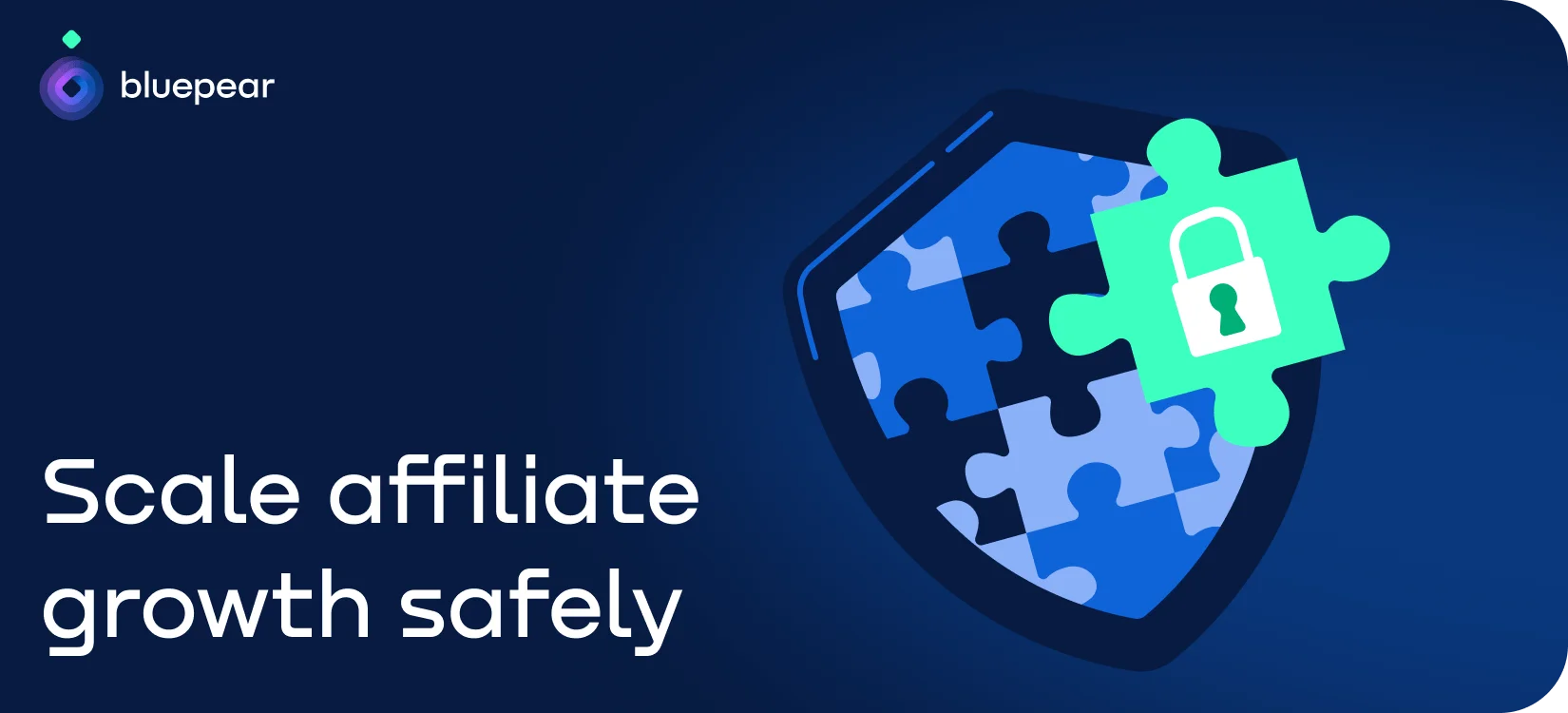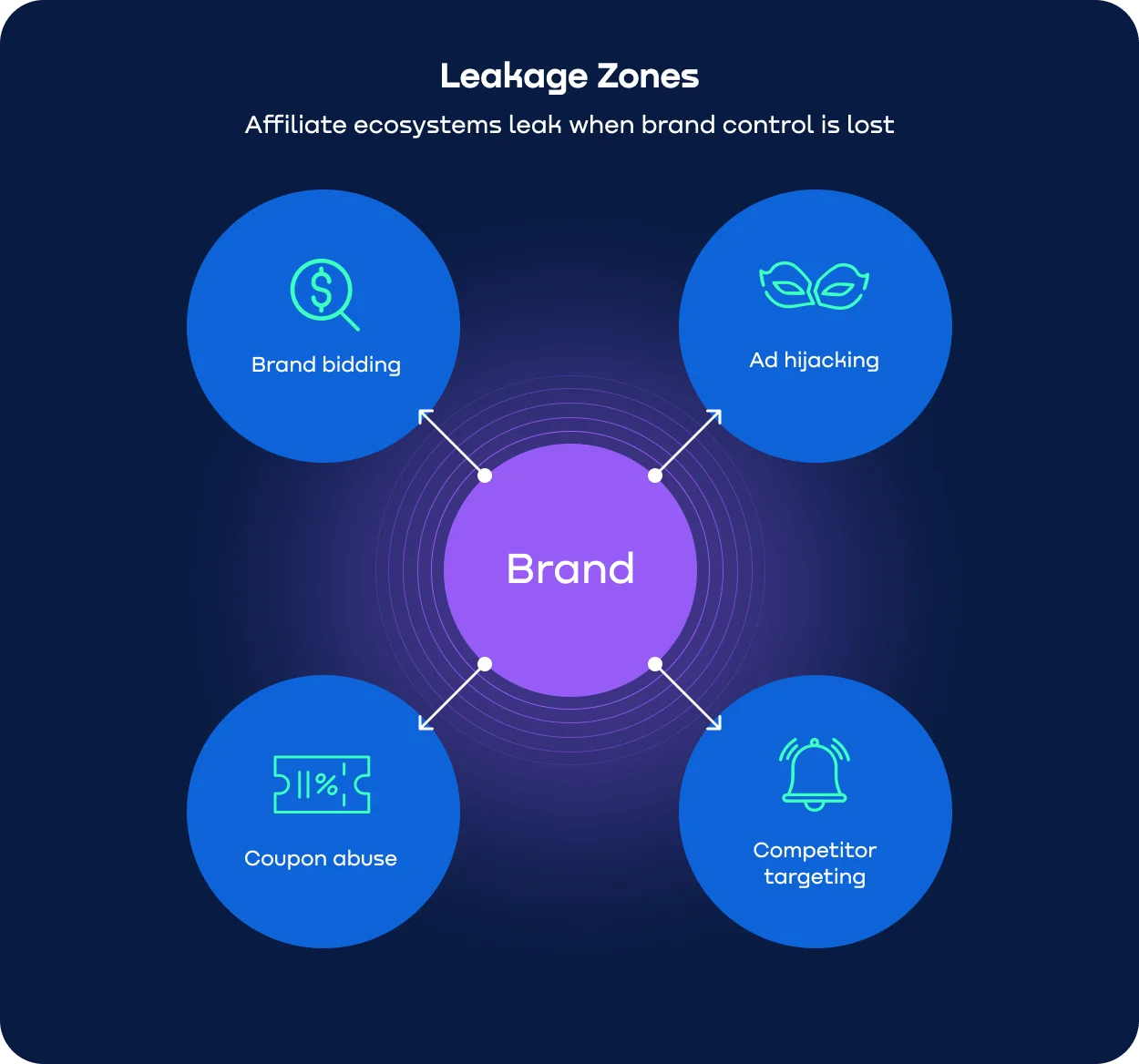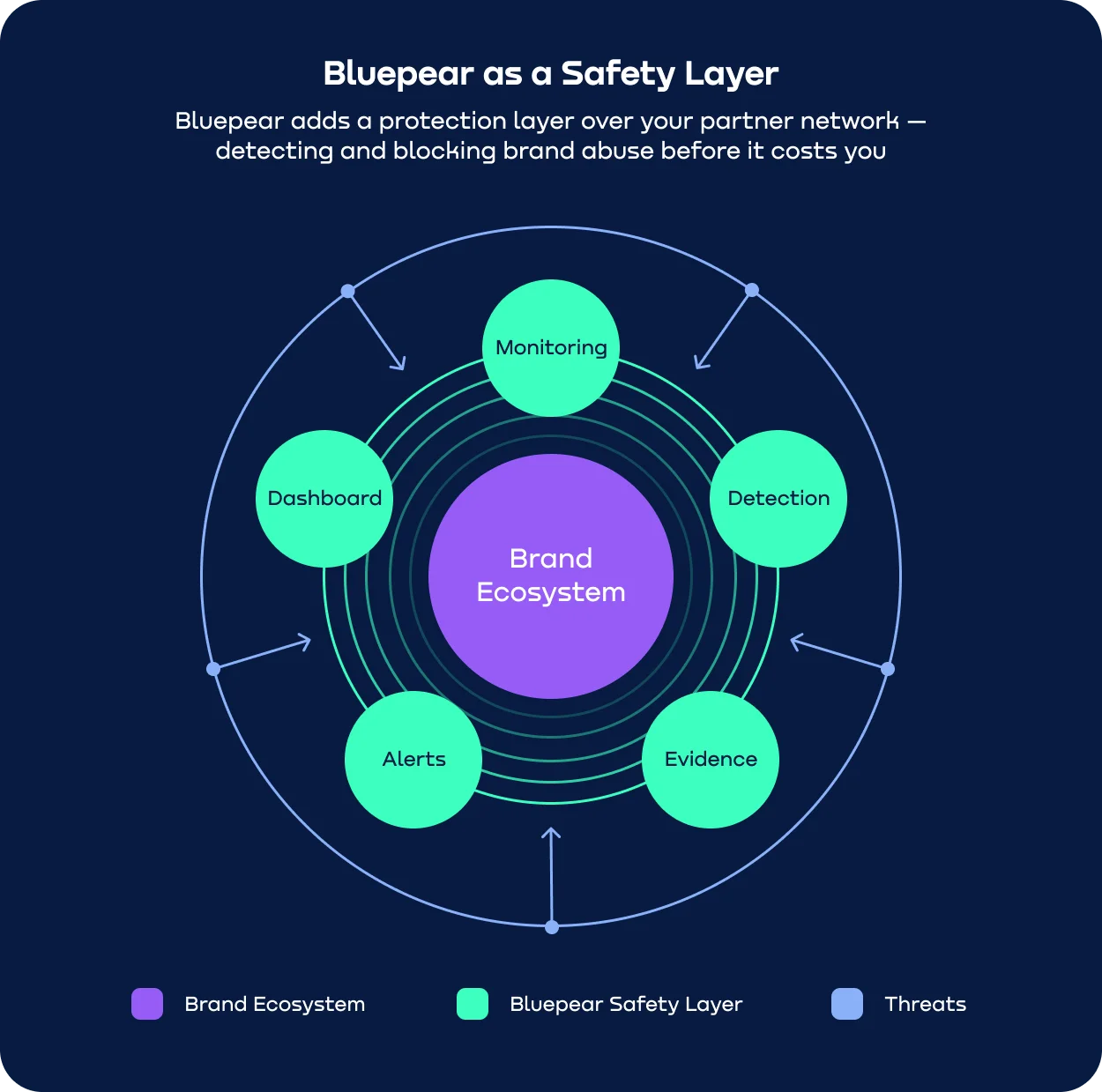Scaling a partner ecosystem without leakage
13.10.2025
Contents
Growth through partners moved from side channel to core engine. Brands with mature programs expand faster, open new markets, and reduce acquisition risk. A wide network creates reach internal teams cannot match. Scale also reduces control. Affiliates, coupon sites, and PPC partners sometimes bend rules. Brand bidding appears in search. Ad hijacking copies ad text and masks domains. Coupon pages capture last click credit with unapproved codes. Leaders need airtight governance, including affiliate protection, to protect return on investment across the whole partner ecosystem.
What a partner ecosystem looks like in 2025
A simple definition helps. A partner ecosystem equals a network of affiliates, integrators, resellers, agencies, and platforms aligned to shared revenue goals. Data flows across tools and storefronts. Contracts and incentives bind the network. Clear roles keep overlap low. Ecosystems outperform standalone partnerships. Shared assets and co-marketing create compounded reach. Integration catalogs unlock new use cases. Community effects attract more ecosystem partner categories over time.
Examples of successful partnership patterns
Real-world patterns show how value emerges. App marketplaces connect developers and merchants. Reseller alliances bring products into local markets. Affiliate programs reward scale-minded publishers. Strategic technology alliances tie products together for joint solutions. All of these models can sit inside one partner network with layered incentives and unified reporting.
Types of ecosystem partners
Programs work best when every ecosystem partner has a defined role and a clear success metric.
-
• Affiliates and publishers
-
• Influencers and creators
-
• Comparison and review media
-
• Coupon and deal sites
-
• PPC specialists and search agencies
-
• Technology integrations and ISVs
-
• Resellers and distributors
-
• Marketplaces and aggregators
-
• Data providers and feed managers
-
• Agencies for creative, PR, and CRO
-
• Communities and education platforms
A tidy roster makes onboarding faster and keeps the partner ecosystem strategy coherent.
Advantages and challenges
Benefits motivate investment, while friction points demand controls. The table below compares both sides so teams can tune partner ecosystem management from day one.
markdown
| Advantages | Typical challenges |
|---|---|
| Faster market entry through local experts | Overlapping roles and channel conflict |
| Lower CAC through pay-for-performance | Data silos and opaque attribution |
| Access to niche audiences | Affiliate policy breaches and weak affiliate compliance |
| Co-marketing and co-selling scale | Coupon abuse and unauthorized codes |
| Rich first-party insights from partners | Ad hijacking and brand bidding in search |
| Resilience through diversified traffic | Revenue leakage and budget waste |
| New product ideas via integrations | Complex contract terms across regions |
Governance strengthens outcomes. A partnership ecosystem framework helps align incentives, reporting, and escalation paths.
Trends shaping programs in 2025
Privacy rules change how teams attribute conversions. Server-side tracking improves resilience. Search platforms push more automation, so policy filters matter more. AI speeds landing-page cloning, which increases hijacking risk. Coupon fraud prevention tools gain adoption as finance leaders target clean revenue. Joint solutions and integration marketplaces grow, pulling more ecosystem partner categories into a unified catalog.
Leakage zones you must watch
Leakage robs growth and distorts data. Three zones appear most often.
- • Brand bidding: partners trigger ads on branded keywords and intercept intent meant for direct channels.
- • Ad hijacking: actors mirror copy, tracking templates, and display URLs to blend in with genuine ads.
- • Coupon sites: pages publish unapproved promos, capture last click at checkout, and overwrite true sources.

Documentation and fast escalation stop the spread. Strong policy language deters repeat offenders and keeps the partner ecosystem clean.
Why leakage blocks growth
Four impacts appear in dashboards and finance reports.
-
• Loss of transparency leads to distorted ROI. Poor data causes bad budget calls.
-
• Rising CPC drives weaker efficiency. Direct search loses auctions to rule breakers.
-
• Payouts for fake or misattributed leads drain budgets. Finance teams chase clawbacks.
-
• Trust erodes within the network. Partners who play fair feel punished, and churn rises.
Revenue leakage prevention becomes a core pillar of every partner ecosystem strategy.
How to protect the network
Leaders can act before damage snowballs. A short playbook helps.
-
• Write clear rules in every contract. Ban brand bidding in PPC across exact, phrase, and broad matches.
-
• Audit coupon sites and PPC partners every week. Tag ecosystem partner pages with UTM standards.
-
• Add automated monitoring across search and shopping placements. Flag sudden shifts in impression share. An effective solution for this is paid search monitoring, which provides 24/7 control.
-
• Preserve evidence: screenshots, redirect chains, whois records, and affiliate IDs.
-
• Escalate in real time through a single inbox. Track cases to closure instead of waiting for complaints.
With those basics in place, partner ecosystem management can focus on growth initiatives.
Bluepear: safety layer for a modern program
Bluepear adds compliance infrastructure to any partner ecosystem. The platform monitors search results around the clock and captures proof of policy breaches. Teams see screenshots, redirect trails, domains, and partner links inside one case.
-
• Core capabilities support affiliate compliance at scale:
-
• Continuous SERP scanning across markets
-
• Automatic detection of brand bidding and hijacking
-
• Evidence capture for legal and finance teams
-
• Actor classification: competitor, ecosystem partner, coupon site
-
• Alerting via email, Slack, and ticketing tools
-
• Case pipeline and dashboards: New, then In Progress and Resolved
-
• ROI outcomes: lower CPC, blocked leakage, cleaner attribution
Bluepear does more than alerts. Playbooks guide outreach to violators. Benchmarks show top leakage zones by market. Leaders restore confidence across the partnership ecosystem framework and report clear wins to executives.

Building a durable operating model
Success follows a repeatable process. Start with goals binding every ecosystem partner to revenue targets and brand safety rules. Map roles and KPIs across affiliates, PPC teams, and integrators. Draft a partner ecosystem strategy rewarding compliance and signaling zero tolerance for shortcuts.
Expand with measured onboarding. Add training on search policy, coupon governance, and creative guidelines. Share playbooks for brand usage and landing-page standards. Provide product feeds and approved copy blocks to reduce guesswork.
Instrument tracking from the outset. Use server-side tagging, coupon allowlists, and clean source parameters. Feed events to analytics and attribution tools. Connect Bluepear alerts to CRM and ticketing so evidence stays linked to accounts and payouts.
Run quarterly business reviews per segment. Compare contribution and compliance health per ecosystem partner. Adjust commission tiers to reward clean growth. Swap underperformers with new candidates from regions needing coverage.
Partner ecosystem management in practice
Operations thrive on cadence. Weekly triage aligns marketing, legal, and partnerships. Monthly reviews reconcile payouts and clawbacks. Quarterly sessions refresh the partner ecosystem strategy and retire legacy clauses no longer fit.
Talent matters. Assign an owner for policy, another owner for operations, and a data analyst for instrumentation. Simple roles keep speed high and cut “too many cooks” delays.
Technology stack makes the difference. Combine an affiliate platform, collaboration tools, analytics, and Bluepear. A partnership ecosystem framework that links contracts, policy, data, and monitoring reduces risk as the roster grows.
Conclusion
A well-run partner ecosystem drives efficient growth. Leakage reverses gains and distorts data. Strong policy, constant monitoring, and clear evidence close the gap.
Bluepear provides the missing guardrail for scaled affiliate programs. Add a safety layer over contracts and dashboards, then grow with confidence.
Document a partner ecosystem strategy and publish operating guides for partner ecosystem management. Align every ecosystem partner on terminology, KPIs, and escalation lanes. Teams gain shared context and move faster with fewer conflicts.
FAQ
How do teams define success for a partner program?
Set revenue, margin, and compliance targets. Add milestones for integration launches and co-marketing.
What signals a leak in search?
Sudden spikes in branded CPC, falling impression share on exact match, and click patterns routing through odd domains.
How often should audits run?
Weekly checks catch new actors early. High-velocity seasons may need daily sweeps.
How to handle a coupon site capturing last click?
Move to an allowlist. Enforce approved codes only. Reduce commissions on policy breaches and restore rates after clean performance.
Where does Bluepear fit in the stack?
Bluepear sits as a safety layer. Monitoring and case management protect investment and make every ecosystem partner more accountable.
Ready to lock down search and coupon channels and scale revenue without waste?

